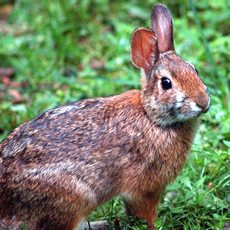

Appalachian Cottontail
|
Creature Profile
The Appalachian cottontail is a rare and descendant species of the cottontail rabbit. It is termed as "rare" because its area of occupation is limited to the upland areas east of the United States. Appalachian cottontails resemble eastern cottontails, however Appalachian cottontails are smaller, lighter and have a black patch between the ears. The eastern cottontail possesses a white spot on the forehead which the Appalachian cottontail does not have. The Appalachian cottontail is lighter with yellowish brown fur. Its neck is mixed with brown and red patches and its dorsal side is mostly black in color. Its belly is white. It weighs an average of 1.8 lbs, and its body length is an average of 6.2 inches. Females are relatively larger than males. Appalachian cottontails have a short lifespan of up to one year. They are usually active at dawn.
The Appalachian cottontail diet is primarily made up of vegetation. It feeds on mountain laurels, green briar, blueberry brushes, alders, chokecherry trees, grasses, forbs, conifer needles, bark and twigs of black cherry and aspen trees, blackberries, leaves and fruits. It also practices coprophagy (eating its own feces). Coprophagy is useful in helping it take some nutrients in the feces, particularly vitamins. The Appalachian cottontail has a love for elevated areas in coniferous forests. It is also found in areas with dense cover such as mountain laurels, rhododendron, blackberry vines, green briar, cane and blackberry. It is sometimes found in lower elevations in areas offering suitable habitats. Geographically, it is found in the Eastern United States, especially in the Appalachian Mountains from the Hudson River in New York to the North of Alabama.
Not much is known about the breeding habits of the species. Males are believed to form hierarchies by fighting to dominate other males. The dominating males have several partners who he mates with to give rise to a new offspring. Breeding occurs from late February to early October. Cottontails are very prolific, and adult females are known to mate even after birth. Gestation period takes 28 weeks after which the female bears a litter of 3-4 young. The young are born blind and helpless and open their eyes on day seven. They leave their nests between days 11 and 14, and they become independent of their mother at the end of the first month. They reach sexual maturity between the first and second month of age.
The Appalachian cottontail is considered to be "near threatened" due to its limitation to high elevations. Threats to the species include urbanization, hunting by sportsmen, and destruction and loss of habitat. Conservation measures are currently underway which include population monitoring and survey, public education to create awareness, and the establishment of management plans witin the state.
Wikipedia Article

|
Wikipedia Article Copyright Notice: This article is licensed under the GNU Free Documentation License. It uses material from the Wikipedia article "Appalachian cottontail". |
April 1, 2017
Glenn, C. R. 2006. "Earth's Endangered Creatures - Appalachian Cottontail Facts" (Online). Accessed 4/18/2024 at http://earthsendangered.com/profile.asp?sp=13239&ID=9.
Need more Appalachian Cottontail facts?




